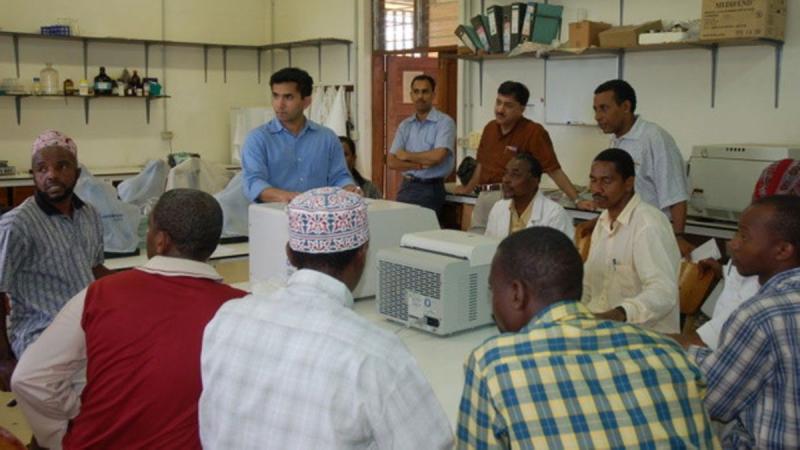
In 2018, tuberculosis, or TB, accounted for around 10 million new cases with 1.5 million lives succumbing to the disease across the globe. The death rate is higher in low- and middle-income countries due to limited access to quality treatment and diagnosis. Mycobacterium tuberculosis, the bacterium that causes the infection, belongs to the family Mycobacteriaceae, which also has other bacteria. Some strains of Mycobacteriaceae can cause other TB-like diseases (OTD), which mimic tuberculosis in signs and symptoms, but have a different clinical treatment. As a result, healthcare workers are often confused and start such patients on anti-tuberculosis treatment. When these patients also have HIV, it leads to complications, as HIV patients are more likely to develop active tuberculosis, the contagious form of the disease, because their immunity is compromised.
Now, an international study, led by researchers from the USA, which also included researchers from India, have designed a point-of-care testing approach for individuals suffering from TB. The study, published in the journal Science Translational Medicine and supported in part by the Bill and Melinda Gates Foundation, proposes a rapid, cost-effective, and readily accessible triage test kit that can be used at the site of patient care. It is based on proteins which act against TB and are found circulating in the blood at elevated levels in TB patients. A triage test prioritizes the patient’s treatment depending upon the gravity of their illness.
Very often, a significant amount of time and resources are wasted due to incorrect diagnosis, especially for those suffering from OTDs. Such misguided treatment not only puts the patient at risk but also drains the healthcare system of essential resources. The proposed test can prevent and control TB by distinguishing it from other similar conditions within an hour.
Traditional approaches to detecting TB can be inaccurate and time-consuming. At the same time, modern methods require the use of expensive laboratory set up which are not readily available in all areas where TB is prevalent. Besides, sputum-based diagnosis is slow, inaccurate and poses a challenge for regions that have a high burden of the disease. It is also challenging to obtain sputum from individuals with AIDS, as they have a low level of sputum and from children who tend to offer saliva instead of coughing up actual sputum. Thus, there is a need for a faster and sensitive blood test that can be performed on patients irrespective of their HIV status in limited laboratory facilities.
The researchers of this study first looked for potential biomarkers in 406 patients from Tanzania and the Philippines, who were diagnosed with persistent cough and symptoms suggestive of TB, by measuring the levels of 47 different proteins in their blood. These samples were then analysed using a machine learning technique that identified four host proteins, which stimulate immune responses—three types of interleukin and VEGF (vascular endothelial growth factor). These proteins are found in elevated levels in patients with active TB.
Remarkably, the algorithm was able to detect the presence of active TB with 65% specificity and 86% sensitivity—telling apart true positives and true negatives. The researchers further developed an ultrasensitive immunoassay to improve the performance of their test model and screen protein levels in a small quantity of blood.
During the second phase of testing the algorithm, 317 specimens from South Africa, Vietnam and Peru were used to identify active TB. The results were comparable to the first set and were unaffected by the presence of HIV-infection or latent TB. Interestingly, the addition of a fifth marker, which is from the bacterium, further improved the accuracy of the testing and brought it closer to the criteria laid down by the World Health Organisation (WHO). However, additional work in this regard remains to be done, say the researchers.
“Presently, we need to improve the assay slightly to achieve performance that meets the WHO criteria for a triage test. In later stages, we hope to translate the assay to multiple sites in the developing world to ascertain how it performs in a real-world environment,” says Dr David R Walt, the corresponding author of the study.
He is a professor, Department of Pathology at Brigham and Women’s Hospital, Harvard Medical School and Core Faculty, Wyss Institute for Biologically Inspired Engineering at Harvard University.
Being among the top ten leading causes of death, Tuberculosis (TB) presents a dreaded challenge not just to public health but also to the economy. The ability to distinguish it from other infections remains key to achieve the WHO target of eliminating TB by 2030. A faster, sensitive and specific triage test, as designed by the researchers of this study, provides a vital step in this regard.
“It is important to point out that our test is a triage test; that is, it aims to determine who should undergo the more extensive and expensive confirmatory diagnostic testing and who should not. Right now, everyone presenting with TB-like symptoms, such as is typical of most upper respiratory infections, is tested using costly diagnostic procedures. If we can implement our assay, it will be less costly and can be more widely used, which should reduce the burden of disease in many TB-endemic populations,” concludes Dr Walt.
This article has been run past the researchers, whose work is covered, to ensure accuracy.
